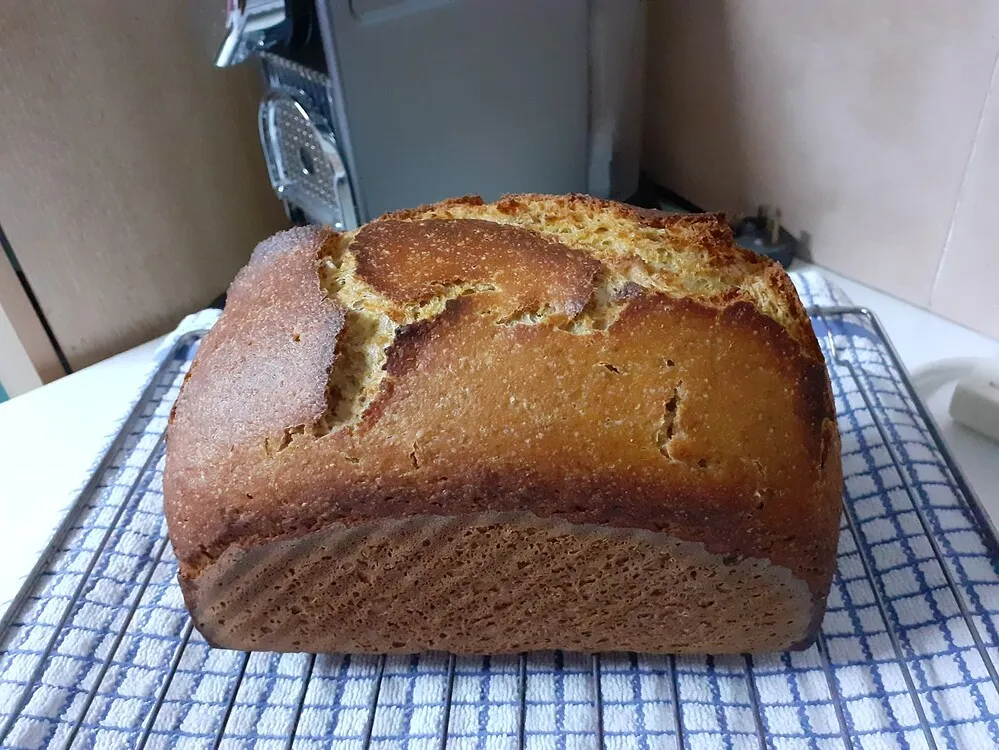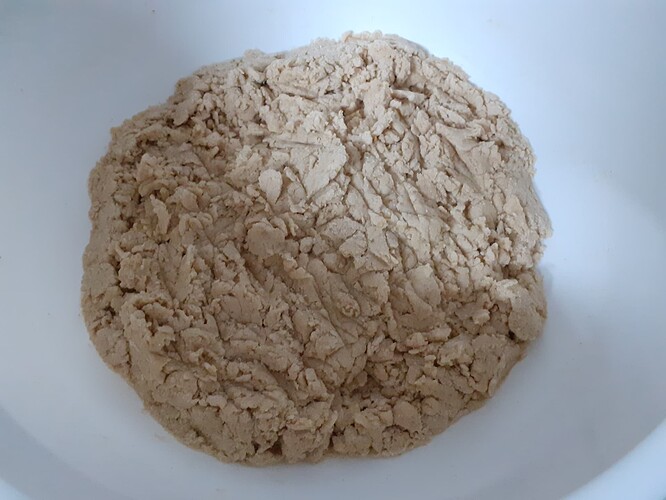
Biga:
- 450g wholegrain emmer flour
- 230g water
- 40g refreshed active raisin yeast water
Mix roughly. Do not form a dough. Should resemble wet sand. Place bowl in plastic bag and leave to ferment for 10-12 hours. Since it’s low hydration (60%) for 100% wholegrain it won’t expand much. To tell it’s ready the bag will be wet from condensation and it’ll have a lovely aroma.

Just After Mixing
Final Dough:
- All of Biga
- 150g wholegrain emmer flour
- 11g salt
- Enough water to make a nice dough
- Form the dough and knead for 10 minutes.
- Keep at room temperature for 1.5 - 2 hours giving it a fold after one hour.
- Refrigerate for 6-7 hours by which time it’ll be well risen.
- De-gas completely, form into a log and place in loaf pan.
- Final proof till ready. About 1.5 - 2 hours.
- Bake.
Looks excellent from the outside. Waiting to see the crumb. Is there much actual gluten formation? What did the dough feel like at the various stages at which you handled it?
Happy baking.
Ted
There's not much use in over kneading. A gentle few minutes to get a good dough is enough. There is gluten formation but it's a bit weird. It can feel strong but not have much extensibility at the same time. It's also not sticky while you keep kneading but attains stickiness when you stop kneading.
Thank you, Ted. I'm sure it'll taste very nice. Didn't pay much attention to keeping a holey crumb. That's why I de-gassed the dough fully when shaping. It's an Emmer pan loaf so no use in aiming for a fancy crumb. It should have a close crumb but not be dense. And i'm hoping for a flavoursome somewhat sweet taste.
Great looking loaf Abe! I find the use of a biga and yeast water helps form a strong dough right from the initial mix. I haven't tried it with 100% Emmer, but I'm curious if you had a good cohesive dough early in development.
Because it's the first time i've done it with whole wheat emmer (and quite a while since i've baked with emmer) I couldn't say if it brought any difference in how it handles. I will say this though... Making and incorporating the biga was far easier than doing so with bread flour. This is probably due to the type of gluten emmer has. It did handle a lot like spelt (no surprises there with emmer being a parent grain). I find with emmer and spelt while it's being kneaded it's not sticky but as soon as you stop it takes on a more tacky feel. On the whole it was actually a pleasure to work with. I've also gotta say the aroma of this bread while baking was out of this world. I just hope it reflects in the eating.
Abe, I have a couple of questions. First, I don't have a water yeast and instead have only my standard sourdough starter. What sort of adjustment should I make regarding the biga?
Second, approximately how much water is used in the final dough? Do you have any estimate?
Thanks.
Ted
I normally don't like to recommend unless i've tried. Yeast Water and Sourdough are different. But i'll make an educated guess...
Use 20g of mature starter that has recently been fed. And watch the ferment! Try not to go over. Keeping the hydration low and fermenting cool would be my advice.
Oh that is difficult to say. I went totally by feel. Tried to go as high as possible but still nice to handle. Didn't feel like battling with the dough. Another guess would be 75-80% hydration but I really couldn't say. Should make a nice smooth dough not too high that it's sticky but not too low that it sort of breaks when folded. I rarely measure water nowadays unless it's a pre-ferment or starter build. Like to work with doughs that feel right to me.
If you haven't seen it yet then look up "Abel 90% biga" who first brought to our attention this Italian biga style which I adapted for my Emmer recipe. I did find that Emmer, although not as easy to work with than bread flour, did have some advantages when using this method. One of which is making and incorporating the biga. Instead of 45% hydration biga I did increase it to 60% because it's 100% wholegrain.
Forgot to ask also about what the baking temperature was and how long you left the loaf in the oven.
I have found this works well for me in my oven and when using a pullman loaf pan. This may vary for you.
210C for 30 minutes with lid on.
5 minutes with lid off then take out of the pan and return to the oven until you get an all over crust colour you're after.
Nice bake Abe, I like the process! :)
I'm sure it tastes delicious!
I barely recall ever using Emmer wheat, I'm sure I must have at some point. Might have to remind myself of its flavour.
Some the Spelt we grow in the UK is truly delicious, where did you source your Emmer flour, UK grown?
While Emmer certainly comes with its own challenges it does a good job, when it comes to how it handles, when incorporating a biga. I do find a bread flour biga is more difficult to incorporate when making the final dough. Curiously although emmer is a parent grain to spelt it seems more elastic than extensible where spelt is vice versa. It has a lovely soft velvety crumb with a slightly sweet flavour.
Went online and bought from Doves Farm a packet of Emmer, Einkorn and Heritage Seeded Flour.
I know the Einkorn is UK grown. Not sure about the Emmer. Which Soelt have you been working with?
Out of interest I decided to see what studies have been done on Emmer wheat and took to Google Scholar to do a bit of reading...
Emmer gluten is certainly weak, but indeed shows some resistance, similar to harder wheats such as khorasan, durum.
The spelt flours I have used are:
I especially remember the Sharpham Farm Spelt being very flavoursome!
Very interesting! I'd say it appeared to ferment very similar to Khorasan. By that I mean it has no, or very little, extensibility so when it rises you get those pits in the dough. Don't know how to describe it. Perhaps craggy is a better term. It looks over fermented but it isn't. If you de-gas the dough thoroughly, like I did, it's still strong.
Thanks. The next time I treat myself to spelt i'll try those.
Nice bake Abe. Using a biga preferment would bring out all the natural sweetness of the grain. You could actually smell the sugary flagrance from the preferment if done right. All my breads nowadays use a 100% biga preferment.
From the aroma of the done biga to the baking it was really lovely indeed. I don't think i've ever gotten a bake like this. A lovely sweet smell permeated the whole house. I can see this becoming one of my favourite techniques. I'm still one for variation and experimentation but this is a whole other level.
Gorgeous bake Abe. I’ve never had the pleasure of trying emmer yet but your results make me want to get a hold of it when I get home to try it. Love your process as well.
Benny
Based it on Abel's Italian Style biga. It worked a treat. 100% emmer will bring the same handling challenges as kamut or spelt but it really is lovely. Glad I did it this way. Will have to experiment with sourdough starter but with a sweet grain like this I think it'll need a sweet levain approach. One wouldn't wish to overpower the flavour of emmer. I know if anyone can master this it'll be you Benny. I look forward to your ideas.
Very tasty indeed! 100% wholegrain emmer plus a complete degassing after the bulk ferment has resulted in a closed crumb but it isn’t heavy at all. In fact it has a soft crumb with a lovely sweet flavour. I'm really liking this Italian Biga method.